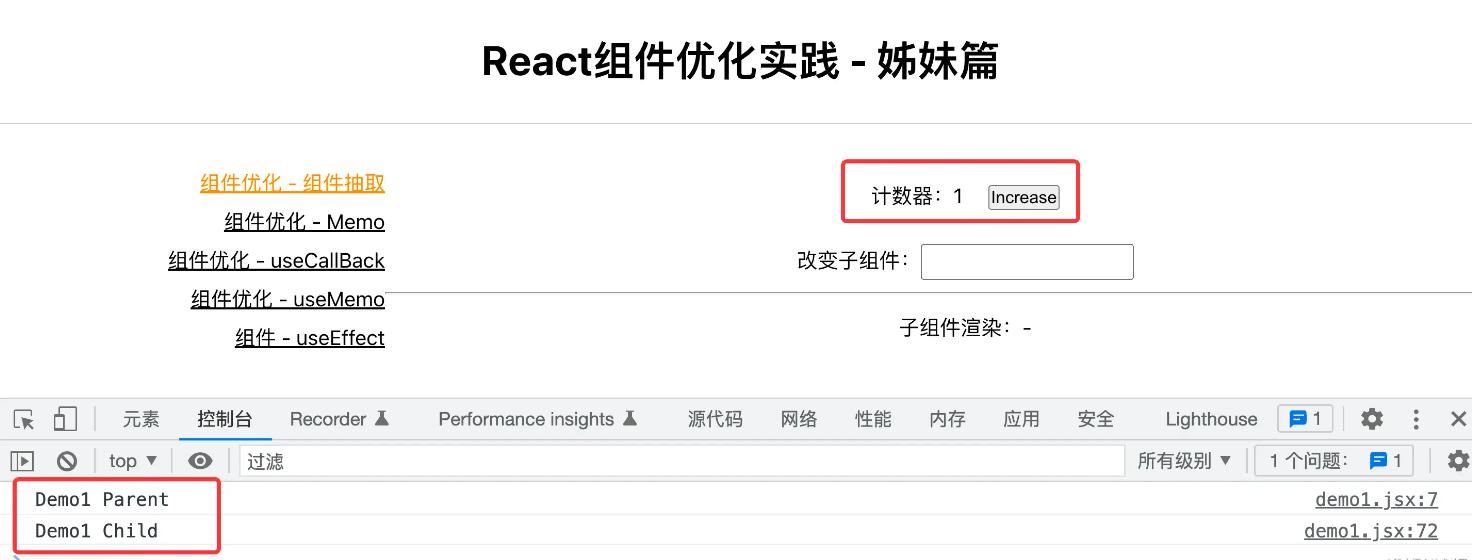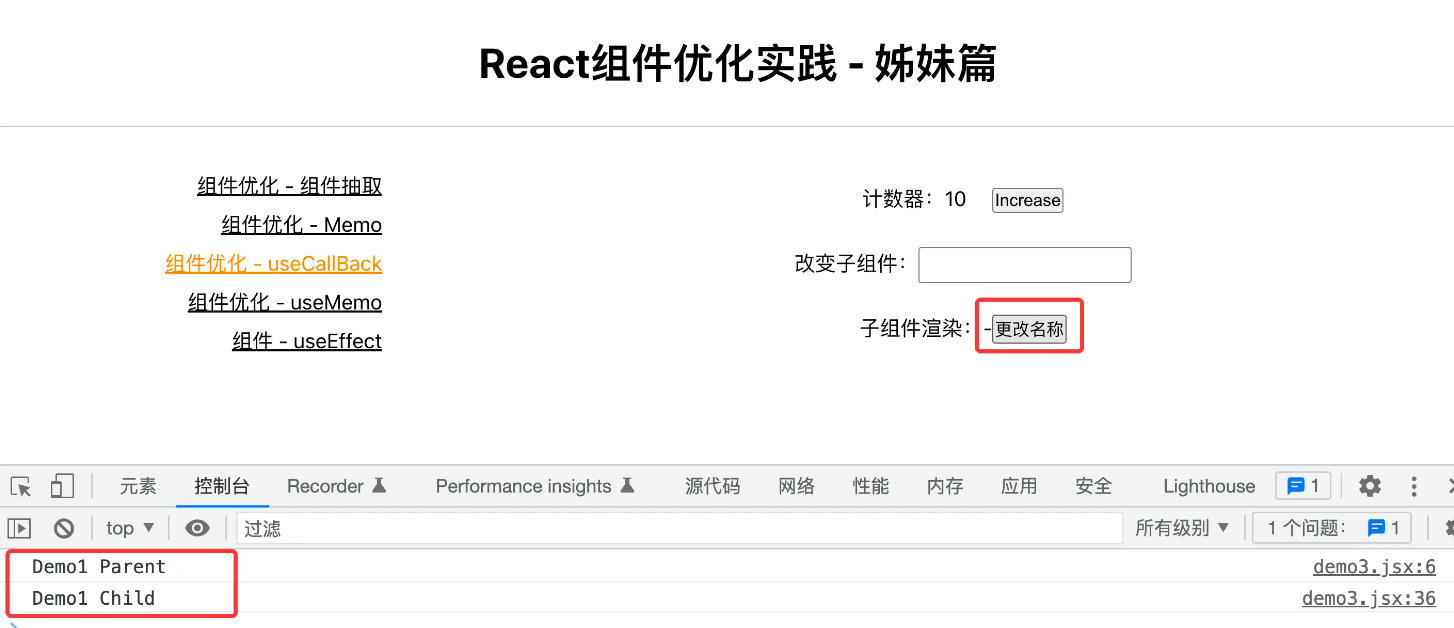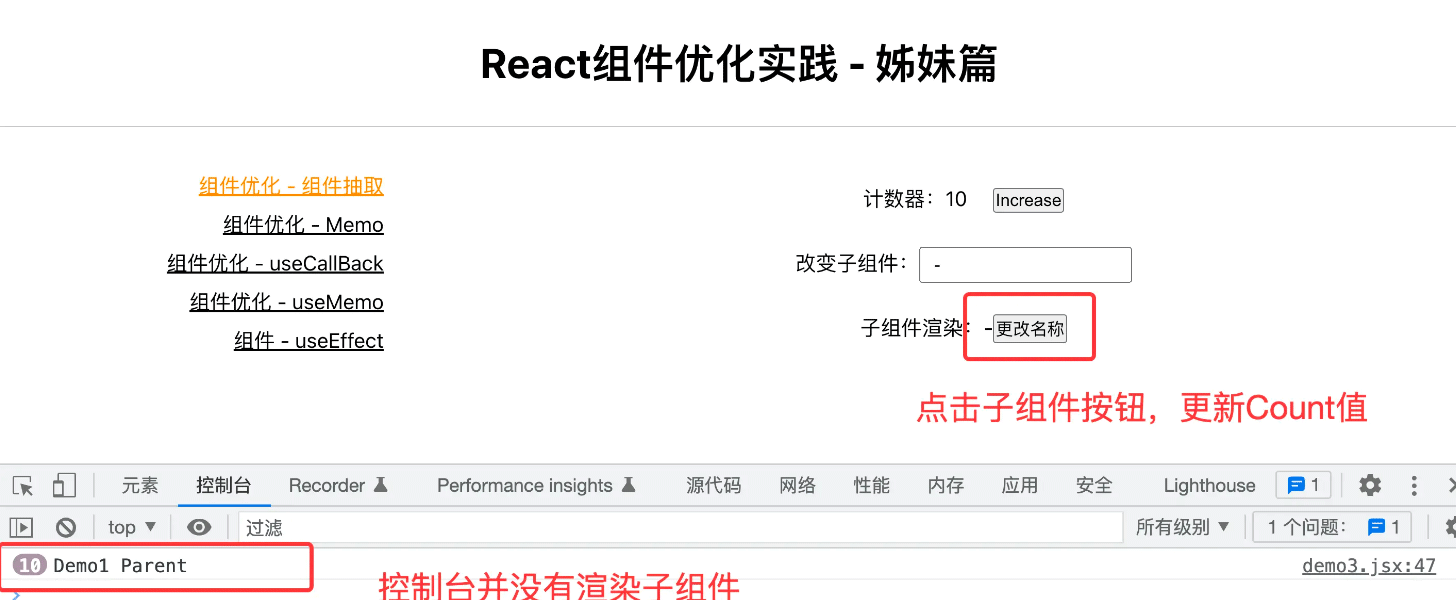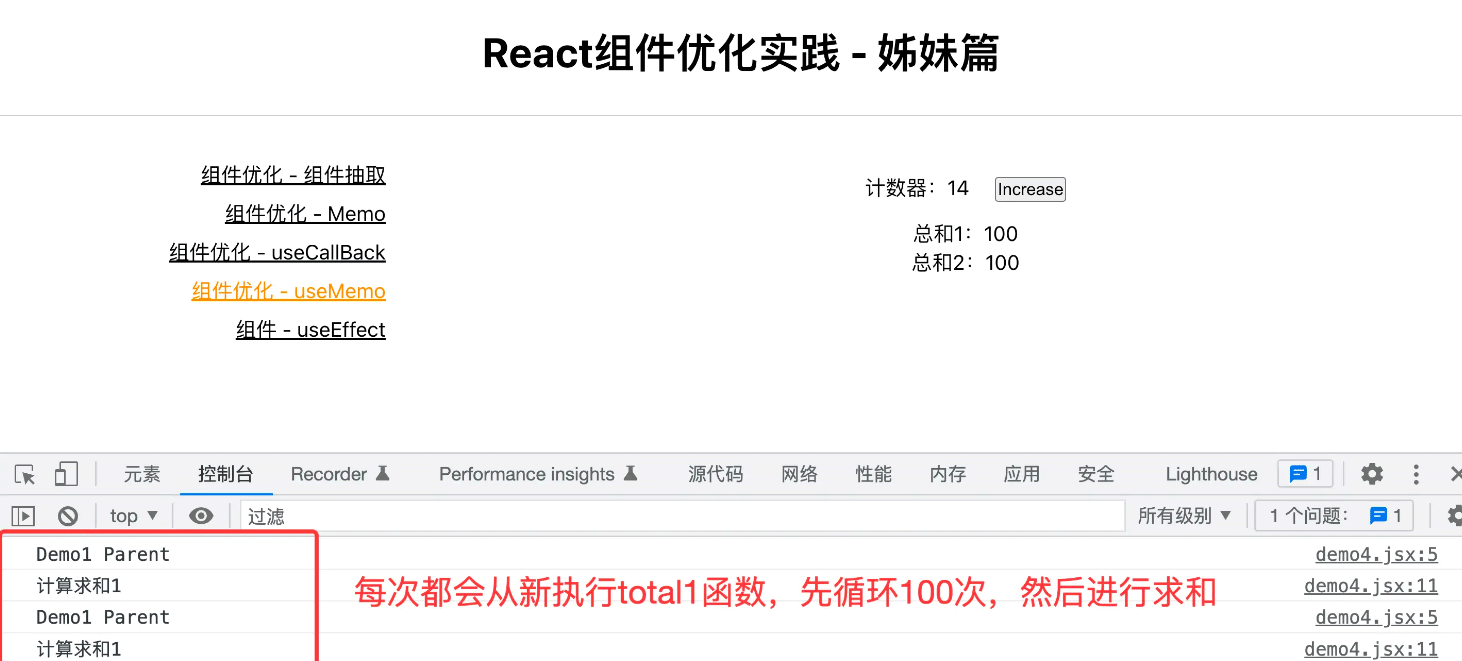React Hook 组件优化
河畔一角 人气:2前言
React Hook 已成为当前最流行的开发范式,React 16.8 以后基于 Hook 开发极大简化开发者效率,同时不正确的使用 React Hook也带来了很多的性能问题,本文梳理基于 React Hook 开发组件的过程中如何提高性能。
组件抽取
优化前
每次点击 Increase 都会引起子组件 Child 的渲染,哪怕子组件并没有状态变化
function Before(){
console.log('Demo1 Parent')
let [count,setCount] = useState(0)
let [name,setName] = useState('-')
const handleClick = ()=>{
setCount(count+1)
}
const handleInput = (e)=>{
setName(e.target.value)
}
return (
<div>
<div className='l50'>
<label>计数器:</label>
<span className='mr10'>{count}</span>
<button className='ml10' onClick={handleClick}>Increase</button>
</div>
<div className='l50'>
<label htmlFor="">改变子组件:</label>
<input type="text" onChange={handleInput}/>
</div>
<hr />
<Child name={name}/>
</div>
)
}
// 子组件
function Child(props){
console.log('Demo1 Child')
return (
<div className='l50'>
子组件渲染:{props.name}
</div>
)
}
优化后
只需要把 Increase 抽取成独立的组件即可。此时点击按钮,子组件并不会渲染。
/**
* 优化后,Increase提取以后,上下文发生变化,组件内
* @returns
*/
function Increase(){
console.log('Child Increase')
let [count,setCount] = useState(0)
const handleClick = ()=>{
setCount(count+1)
}
return (
<div>
<div className='l50'>
<label>计数器:</label>
<span className='mr10'>{count}</span>
<button className='ml10' onClick={handleClick}>Increase</button>
</div>
</div>
)
}
function After(){
console.log('Demo1 Parent')
let [name,setName] = useState('-')
const handleInput = (e)=>{
setName(e.target.value)
}
return (
<div>
<Increase/>
<div className='l50'>
<label htmlFor="">改变子组件:</label>
<input type="text" onChange={handleInput}/>
</div>
<Child name={name}/>
</div>
)
}
// 子组件
function Child(props){
console.log('Demo1 Child')
return (
<div className='l50'>
子组件渲染:{props.name}
</div>
)
}memo 优化组件
同样基于上述优化前代码,如果不抽取组件,使用 memo 优化后,当点击按钮后,也不会触发二次渲染。
// 优化前
function AfterMemo(){
console.log('Demo1 Parent')
let [count,setCount] = useState(0)
let [name,setName] = useState('-')
const handleClick = ()=>{
setCount(count+1)
}
const handleInput = (e)=>{
setName(e.target.value)
}
return (
<div>
<div className='l50'>
<label>计数器:</label>
<span className='mr10'>{count}</span>
<button className='ml10' onClick={handleClick}>Increase</button>
</div>
<div className='l50'>
<label htmlFor="">改变子组件:</label>
<input type="text" onChange={handleInput}/>
</div>
<Child name={name}/>
</div>
)
}
// 子组件
const Child = memo((props)=>{
console.log('Demo1 Child')
return (
<div className='l50'>
子组件渲染:{props.name}
</div>
)
})React.memo 语法
React.memo 为高阶组件,与 React.PureComponent相似。
function TestComponent(props){
// 使用 props 渲染
}
function areEqual(prevProps,nextProps){
/*
如果把 nextProps 传入 render 方法的返回结果与
将 prevProps 传入 render 方法的返回结果一致则返回 true,
否则返回 false
*/
}
export default React.memo(TestComponent,areEqual)与 class 组件中 shouldComponentUpdate() 方法不同的是,如果 props 相等,areEqual 会返回 true;如果 props 不相等,则返回 false。这与 shouldComponentUpdate 方法的返回值相反。
useCallback 优化组件
如果已经用了 memo ,当遇到下面这种场景时,同样会触发子组件渲染。比如,给 Child 绑定一个 handleClick ,子组件内部增加一个按钮,当点击子组件的按钮时,更改 count 值,即使没有发生 name 变化,也同样会触发子组件渲染,为什么?memo 不是会判断 name 变化了,才会更新吗?
function Before(){
console.log('Demo1 Parent')
let [count,setCount] = useState(0)
let [name,setName] = useState('-')
const handleClick = ()=>{
setCount(count+1)
}
const handleInput = (e)=>{
setName(e.target.value)
}
const handleChange = ()=>{
setCount(count+1)
}
return (
<div>
<div className='l50'>
<label>计数器:</label>
<span className='mr10'>{count}</span>
<button className='ml10' onClick={handleClick}>Increase</button>
</div>
<div className='l50'>
<label htmlFor="">改变子组件:</label>
<input type="text" onChange={handleInput}/>
</div>
<Child name={name} handleClick={handleChange}/>
</div>
)
}
// 子组件
const Child = memo((props)=>{
console.log('Demo1 Child')
return (
<div className='l50'>
子组件渲染:{props.name}
<button onClick={props.handleClick}>更改count</button>
</div>
)
})
并不是 memo 没有生效,是因为当状态发生变化时,父组件会从新执行,导致从新创建了新的handleChange 函数,而 handleChange 的变化导致了子组件的再次渲染。
优化后
点击父组件的Increase按钮,更改了 count 值,经过 useCallback 包裹 handleChange 函数以后,我们会发现子组件不再渲染,说明每当父组件执行的时候,并没有创建新的 handleChange 函数,这就是通过 useCallback 优化后的效果。 即使我们点击子组件的按钮,也同样不会触发子组件的渲染,同样 count 会进行累加。
function After(){
console.log('Demo1 Parent')
let [count,setCount] = useState(0)
let text = useRef();
let [name,setName] = useState('-')
const handleClick = ()=>{
setCount(count+1)
}
const handleInput = (e)=>{
setName(e.target.value)
}
const handleChange = useCallback(()=>{
// 为了让 count 能够累加,我们使用ref 获取值
let val = parseInt(text.current.textContent);
setCount(val+1)
},[])
return (
<div>
<div className='l50'>
<label>计数器:</label>
<span className='mr10' ref={text}>{count}</span>
<button className='ml10' onClick={handleClick}>Increase</button>
</div>
<div className='l50'>
<label htmlFor="">改变子组件:</label>
<input type="text" value={name} onChange={handleInput}/>
</div>
<Child name={name} handleClick={handleChange}/>
</div>
)
}
useCallback 作用
// 用法
useCallback(()=>{
// to-do
},[])
// 示例
function App(){
// 点击按钮调用此函数,但返回被缓存
const onClick = useCallback(() => {
console.log('我被缓存了,怎么点击都返回一样');
}, []);
return (
<button onClick={onClick}>点击</button>
);
}useCallback接收 2 个参数,第一个为缓存的函数,第二个为依赖值- 主要用于缓存函数,第二次会返回同样的结果。
useMemo 优化
我们定义了一个total函数,内部使用 1 填充了100次,通过 reduce 计算总和,经过测试发现点击 Increase按钮后,只会执行 total1 ,不会执行 total2,假设total计算量巨大,就会造成内存的浪费,通过 useMemo 可以帮我们缓存计算值。
function Before(){
console.log('Demo1 Parent')
let [count,setCount] = useState(0)
const handleClick = ()=>{
setCount(count+1)
}
const total1 = ()=>{
console.log('计算求和1')
let arr = Array.from({ length:100 }).fill(1)
return arr.reduce((prev,next)=>prev+next,0)
}
// 缓存对象值
const total2 = useMemo(()=>{
console.log('计算求和2')
let arr = Array.from({ length:100 }).fill(1)
return arr.reduce((prev,next)=>prev+next,0)
},[count])
return (
<div>
<div className='l50'>
<label>计数器:</label>
<span className='mr10'>{count}</span>
<button className='ml10' onClick={handleClick}>Increase</button>
</div>
<div>
<label>总和:</label>
<span>{total1()}</span>
<span>{total2}</span>
</div>
</div>
)
}
useMemo 语法
const memoizedValue = useMemo(() => computeExpensiveValue(a, b), [a, b]);
- 传入一个函数进去,会返回一个
memoized值,需要注意的是,函数内必须有返回值 - 第二个参数会依赖值,当依赖值更新时,会从新计算。
useCallback 和 useMemo 区别
他们都用于缓存,useCallback 主要用于缓存函数,返回一个 缓存后 函数,而 useMemo 主要用于缓存值,返回一个缓存后的值。
加载全部内容